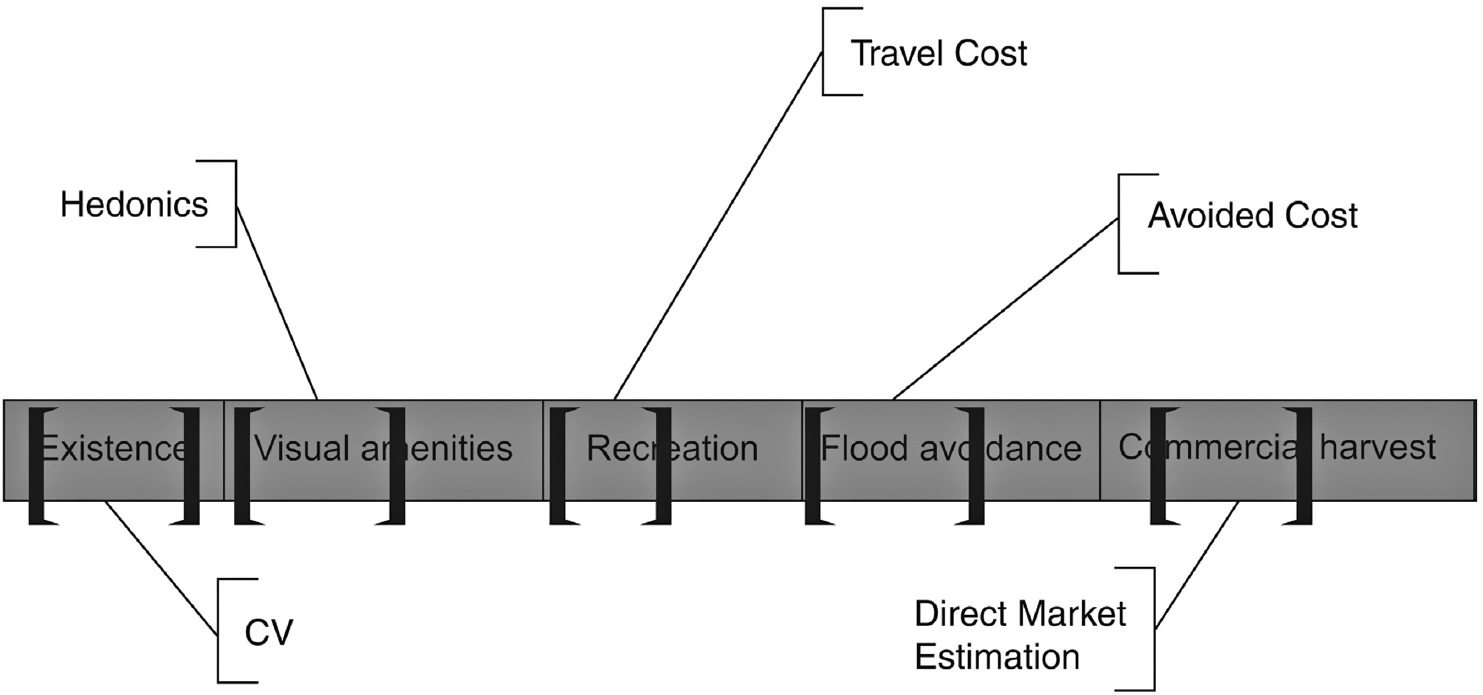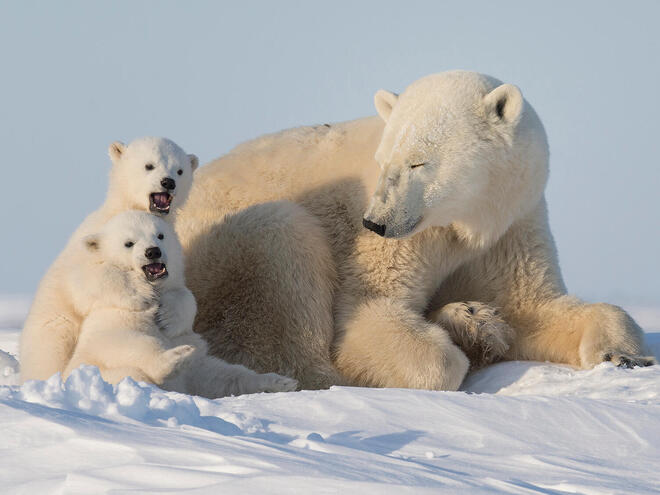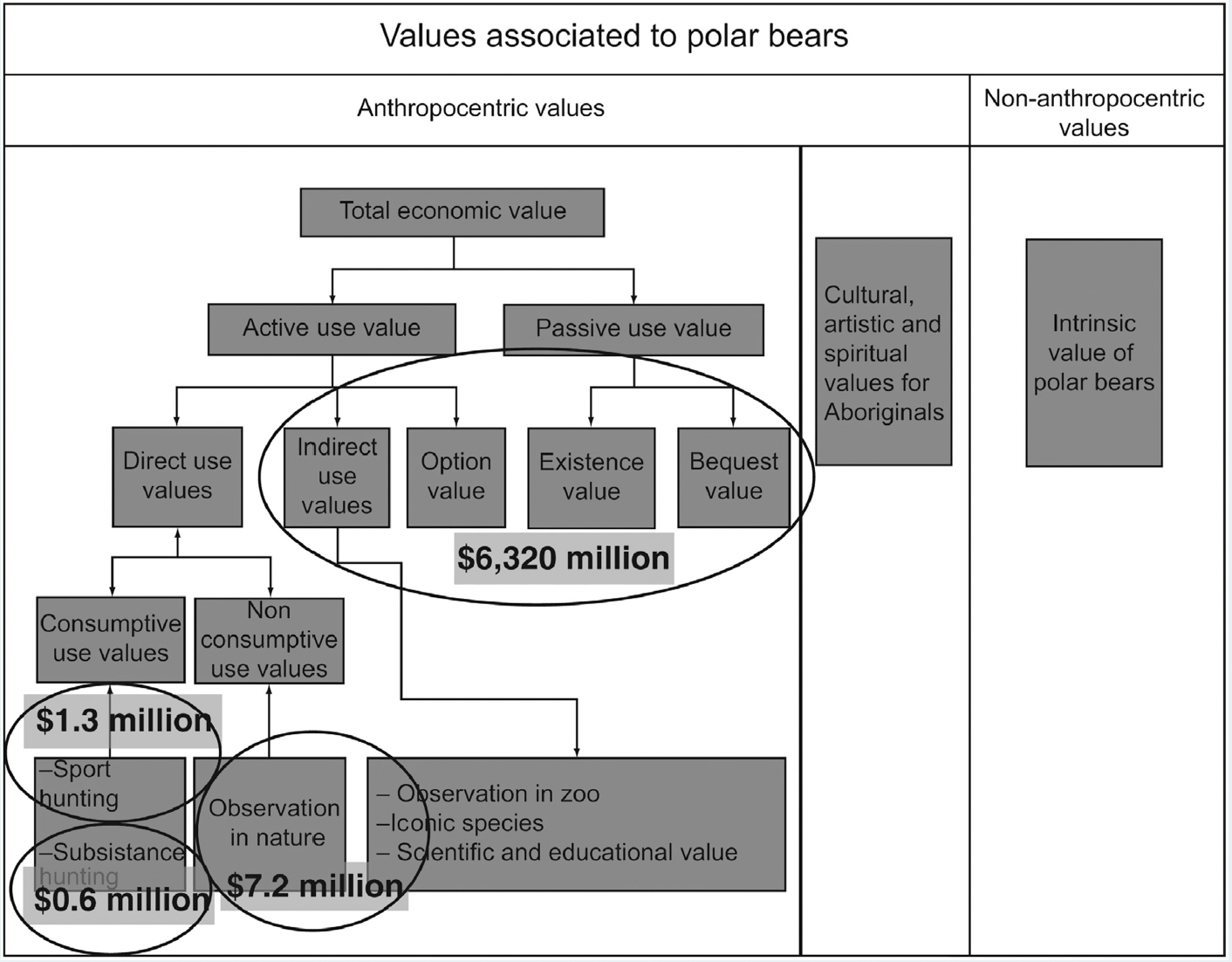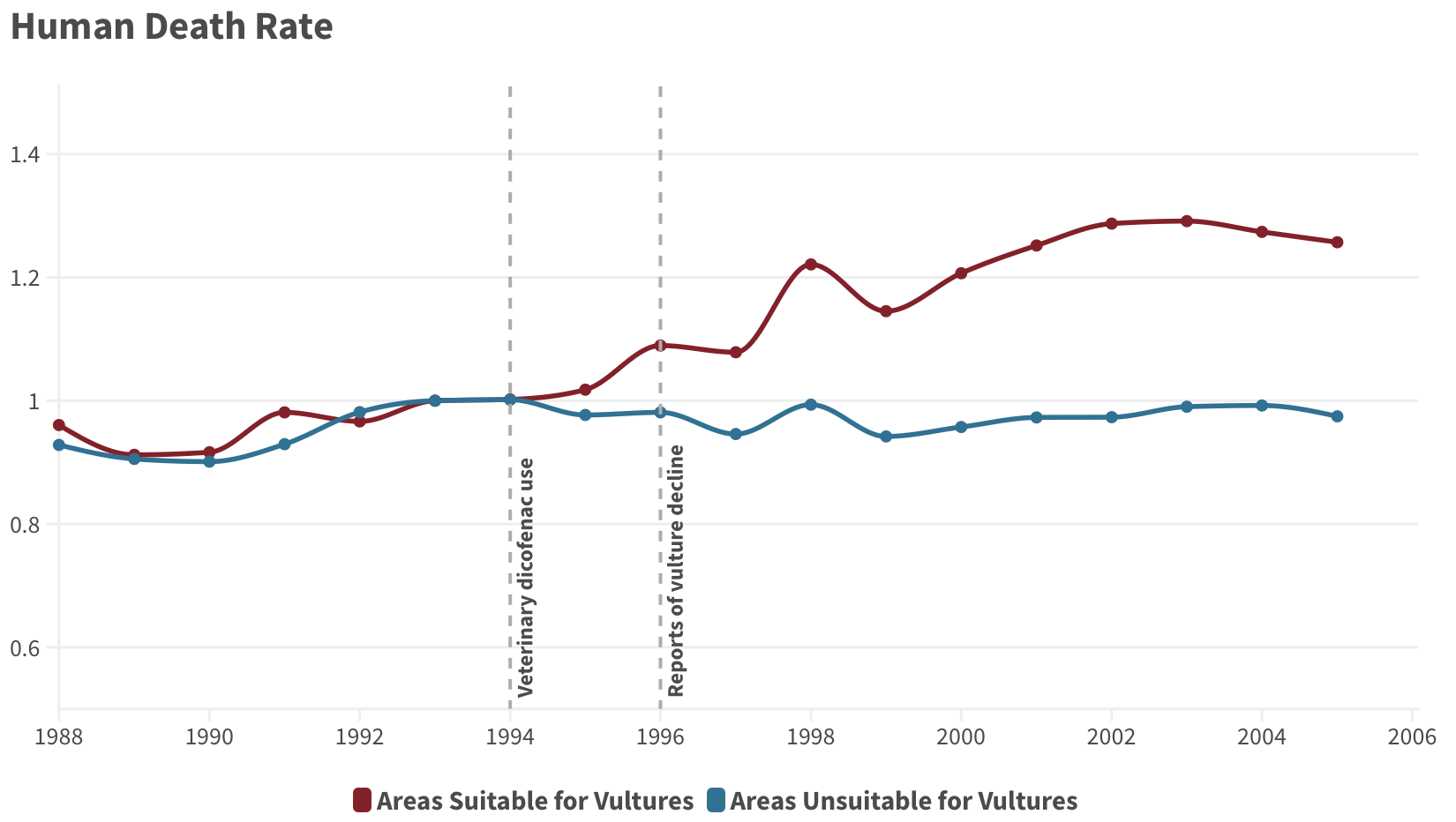Lecture 19
Valuing the Environment: Methods
October 21, 2024
Valuing the Envrionment: Methods
Nonmarket Valuation
Different Methods, Different Experts, Different Data

Each of these methods relies on different data and, many times, different experts.
Rarely is the available time or money sufficient to apply all methods to a particular question.
What Is the Value of a Polar Bear?

Study Purpose: The Canadian government commissioned a study in 2011 to estimate the socio-economic value of polar bears, partially to assess the impact of listing them as an at-risk species.
Comprehensive Valuation: The study captured both active use values (hunting, viewing, research) and passive-use values (existence and bequest).
What Is the Value of a Polar Bear?
- Valuation Methods:
- Used nonmarket valuation methods like travel-cost (viewing), market prices (hunting), meta-analysis, and benefit transfer for passive-use values.
- Stated preference methods (contingent valuation or choice experiments) were not used due to time and budget constraints.
What Is the Value of a Polar Bear?

- Direct Use Values: Made up a small portion of the total estimated value.
What Is the Value of a Polar Bear?
Caveats
- Meat Value Substitutes:
- Polar bear meat was compared to beef and dog food, but alternative comparisons could affect results.
- Sport Hunting Values:
- Estimated using benefit transfer from a 1989 big game and grizzly bear hunting study, translated into 2009 dollars.
- The value may be either underestimated (due to the unique nature of polar bear hunting) or overestimated (due to the charismatic image of the polar bear).
What Is the Value of a Polar Bear?
Caveats
- Passive-Use Values:
- Also estimated using benefit transfer based on a meta-analysis of species at risk.
- Direct uses were excluded from the transferred value, but indirect use benefits were harder to separate, which could lead to overestimation.
What Is the Value of a Polar Bear?
Caveats
- Double Counting Risk:
- Scientific values were calculated separately and also included in preservation value estimates, which may lead to overestimated totals.
- Challenges in Valuation:
- Determining the true value of polar bears is difficult, and estimates may vary significantly based on methods and assumptions used.
Valuing Human Life
Introduction
- Significance: Estimating the value of human life is crucial for allocating resources in government programs aimed at saving lives and reducing illness.
- Challenge: Life is inherently priceless. However, the resources used to prevent loss of life are scarce, choices must be made.
Economic Approach to Valuing Life
- Focus: Valuing reductions in mortality risk, not life itself.
- Value of Reduced Mortality Risk:
- Represents an individual’s willingness to pay (WTP) for small changes in mortality risks.
- Calculated as the marginal rate of substitution between mortality risk and money.
- Also known as the Value of Statistical Life (VSL).
Q&A: Calculating VSL
Scenario:
All else being equal, police officers receive an extra pay of $700 per year. If the excess risk of death for a police officer is 1/10,000 per year, how do you calculate the VSL based on this information?
Answer: Calculating VSL
Determine Total Extra Pay:
Each police officer receives an extra $700 per year.Excess Risk of Death:
The excess risk of death is 1/10,000 per year.Calculate VSL:
\[ \text{VSL} = \frac{\text{Extra Pay}}{\text{Excess Risk of Death}} = \frac{\text{\$}700}{\frac{1}{10,000}} = \frac{700 \times 10,000}{\frac{1}{10,000}\times 10,000} = \text{\$}7,000,000 \] Result:
The Value of Statistical Life (VSL) is $7,000,000.
- This means that 10,000 police officers collectively value the reduction of one statistical life at $7 million per year.
Calculating VSL
- Example Scenario:
- Policy reduces death risk from 1/100,000 to 1/150,000 for 1 million people.
- Expected deaths decrease from 10 to 6.67.
- If each person is willing to pay $5, total WTP is $5 million.
- VSL Calculation:
- VSL = Total WTP / Expected deaths avoided.
- VSL = $5 million / 3.33 ≈ $1.5 million.
- Alternatively, VSL = Individual WTP / Change in risk.
Q&A: Calculating VSL
Scenario:
A safety measure is introduced in cars that decreases the probability of fatal accidents by 0.001% (or 1 in 100,000). If each individual in a population of 100,000 is willing to pay $100 for this reduction in risk, what is the VSL in this scenario?
Is Valuing Human Life Immoral?
Critique of Benefit-Cost Analysis
- Moral Concerns:
- Benefit-cost analysis is argued to be immoral by some critics.
- It represents a retreat from the absolute right of citizens to be free from pollution-induced harm.
- Justifying regulations that allow some pollution-induced deaths violates this right.
Is Valuing Human Life Immoral?
Defense of Benefit-Cost Analysis
- Necessity of Considering Benefits:
- Ignoring benefits of lifesaving measures would be immoral due to resource scarcity.
- Resources should be allocated to produce the greatest good.
- Trade-offs Are Inevitable:
- Eliminating all pollution is impractical and excessively costly.
- People routinely make trade-offs between cost and health risks (e.g., driving speed, medical expenses).
- Inclusivity in Decision-Making:
- Imposing costs without public input is unethical.
- Benefit-cost analysis reflects choices people might make themselves.
- Conclusion:
- While imperfect, benefit-cost analysis provides valuable information.
- Discarding it could harm those it aims to protect.
Empirical Estimates of VSL
- Early Studies (Viscusi, 1996):
- Implied values between $3 million and $7 million (1986 dollars).
- Suggested standard estimate: $5 million.
- Recent Meta-Analyses (Banzhaf, 2021):
- Mean VSLs range from $3.7 million to $12.3 million.
- Central estimate: $7 million.
Factors Influencing VSL
Age Variations
- Inverted U-shaped relationship between VSL and age (Viscusi, 2008).
- Ages 18–24: $3.7 million.
- Ages 35–44: $9.7 million (peak VSL).
- Ages 55–62: $3.4 million.
Factors Influencing VSL
Income and Regional Differences
Different VSL (in $ million) across government agencies and countries
- US EPA: $9.38.
- US FDA: $9.82.
- US DOT & DHS: $10.32.
- European Union: $1.71-3.56.
- OECD: $2.24-4.08.
- Pakistan: $0.3 (or lower).
- Income Elasticity Adjustments:
- Higher income elasticity over time (≥1.0) is used for lower-income countries, while lower elasticity (0.4-0.6) for U.S. agencies.
- Reflects that WTP as a percentage of income drops at very low incomes.
- What limited income is available in poorer households is reserved for basic needs.
Practical Applications of VSL
- Regulatory Benefits
- Mortality benefits account for:
- Over 90% of the benefits of the Clean Air Act (USEPA).
- 69% of the benefits of the European Union Clean Air Package.
- Mortality benefits account for:
- Climate Change Impacts
- Heat-related deaths attributed to climate change (~9,700/year).
- Influences the social cost of carbon by valuing mortality risks.
- Public Health Measures
- VSL used to evaluate the trade-offs between economic activity and lives lost.
- Supported maintaining restrictions to save lives despite economic impacts.
Example: Using VSL to Inform Policy—COVID-19
- Economic Benefits of Public Health Measures:
- Social distancing during COVID-19 could yield economic benefits of about $8 trillion.
- Historical Evidence:
- Studies on the 1918 flu pandemic indicate that cities with early and aggressive interventions saw better economic recovery post-pandemic.
- Key Insights:
- Social distancing and public health policies can lead to both lower mortality rates and improved economic outcomes.
- The perceived trade-off between public health and economic activity is often misleading.
Example: Using VSL to Inform Policy—COVID-19
Estimated U.S. mortality costs at $1.4 trillion in the first half of 2020 using VSL.
Global mortality costs were around $3.5 trillion by early July 2020.
Policy Implications
- Investing in measures to reduce mortality risk during pandemics can be economically justified.
- Benefit-cost analysis aids in determining the cost-effectiveness of such policies.
While this benefit-cost analysis is useful, it requires careful interpretation considering uncertainties in the value of mortality risk reductions and the distribution of impacts across those who are advantaged and disadvantaged.
Example: Using VSL to Measure the Social Costs of Keystone Species Collapse, Vulture in India
Vultures are considered a “keystone species” critical to their surrounding habitat because, as highly-efficient scavengers, they play an important sanitation role.
Farmers have long relied on them to remove the rotting bodies of dead livestock.
But vultures in India came close to extinction in the mid-1990s after an anti-inflammatory drug (diclofenac) used to treat cattle poisoned and killed the birds.
Example: Using VSL to Measure the Social Costs of Keystone Species Collapse, Vulture in India

- Results: Between 2000 and 2005 the loss of vultures caused about 100,000 additional human deaths each year, resulting in $69.4 billion per year in mortality damages.